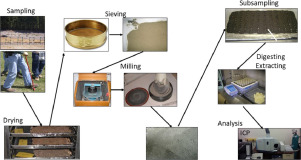当前位置:
X-MOL 学术
›
Microchem. J.
›
论文详情
Our official English website, www.x-mol.net, welcomes your
feedback! (Note: you will need to create a separate account there.)
Effects of Milling on the metals analysis of soil samples containing metallic residues
Microchemical Journal ( IF 4.9 ) Pub Date : 2020-05-01 , DOI: 10.1016/j.microc.2019.104583 Jay L. Clausen , Samuel A. Beal , T. Georgian , K.H. Gardner , T.A. Douglas , Ashley M. Mossell
Microchemical Journal ( IF 4.9 ) Pub Date : 2020-05-01 , DOI: 10.1016/j.microc.2019.104583 Jay L. Clausen , Samuel A. Beal , T. Georgian , K.H. Gardner , T.A. Douglas , Ashley M. Mossell

|
Abstract Metallic residues are distributed heterogeneously onto small-arms range soils from projectile fragmentation upon impact with a target or berm backstop. Incremental Sampling Methodology (ISM) can address the spatially heterogeneous contamination of surface soils on small-arms ranges, but representative kilogram-sized ISM subsamples are affected by the range of metallic residue particle sizes in the sample. This study compares the precision and concentrations of metals in a small-arms range soil sample processed by a puck mill, ring and puck mill, ball mill, and mortar and pestle prior to analysis. The ball mill, puck mill, and puck and ring mill produced acceptable relative standard deviations of less than 15% for the anthropogenic metals of interest (Lead (Pb), Antimony (Sb), Copper (Cu), and Zinc (Zn)), with the ball mill exhibiting the greatest precision for Pb, Cu, and Zn. Precision by mortar and pestle, without milling, was considerably higher (40% to >100%) for anthropogenic metals. Median anthropogenic metal concentrations varied by more than 40% between milling methods, with the greatest concentrations produced by the puck mill, followed by the puck and ring mill and then the ball mill. Metal concentrations were also dependent on milling time, with concentrations stabilizing for the puck mill by 300 s but still increasing for the ball mill over 20 h. Differences in metal concentrations were not directly related to the surface area of the milled sample. Overall, the tested milling methods were successful in producing reproducible data for soils containing metallic residues. However, the effects of milling type and time on concentrations require consideration in environmental investigations.
中文翻译:

研磨对含金属残留物土壤样品金属分析的影响
摘要 金属残留物不均匀地分布在小型武器射程土壤上,从射弹与目标或护堤后挡板撞击时破碎。增量采样方法 (ISM) 可以解决小型范围内表层土壤的空间异质污染问题,但代表性的千克级 ISM 子样本会受到样本中金属残留颗粒大小范围的影响。本研究在分析前比较了由圆磨机、圆磨机、球磨机以及研钵和研杵处理的小型武器范围土壤样品中金属的精度和浓度。球磨机、圆磨机和圆环磨机产生了小于 15% 的可接受的相关人为金属(铅 (Pb)、锑 (Sb)、铜 (Cu) 和锌 (Zn))的相对标准偏差, 球磨机对 Pb、Cu 和 Zn 表现出最高的精度。对于人为金属,研钵和研杵的精度要高得多(40% 到 >100%)。不同研磨方法之间的人为金属浓度中值差异超过 40%,最大浓度由圆磨机产生,其次是圆磨机和环磨机,然后是球磨机。金属浓度也取决于研磨时间,球磨机的浓度稳定了 300 秒,但球磨机的浓度在 20 小时后仍会增加。金属浓度的差异与研磨样品的表面积没有直接关系。总体而言,经过测试的研磨方法成功地为含有金属残留物的土壤生成了可重复的数据。然而,
更新日期:2020-05-01
中文翻译:

研磨对含金属残留物土壤样品金属分析的影响
摘要 金属残留物不均匀地分布在小型武器射程土壤上,从射弹与目标或护堤后挡板撞击时破碎。增量采样方法 (ISM) 可以解决小型范围内表层土壤的空间异质污染问题,但代表性的千克级 ISM 子样本会受到样本中金属残留颗粒大小范围的影响。本研究在分析前比较了由圆磨机、圆磨机、球磨机以及研钵和研杵处理的小型武器范围土壤样品中金属的精度和浓度。球磨机、圆磨机和圆环磨机产生了小于 15% 的可接受的相关人为金属(铅 (Pb)、锑 (Sb)、铜 (Cu) 和锌 (Zn))的相对标准偏差, 球磨机对 Pb、Cu 和 Zn 表现出最高的精度。对于人为金属,研钵和研杵的精度要高得多(40% 到 >100%)。不同研磨方法之间的人为金属浓度中值差异超过 40%,最大浓度由圆磨机产生,其次是圆磨机和环磨机,然后是球磨机。金属浓度也取决于研磨时间,球磨机的浓度稳定了 300 秒,但球磨机的浓度在 20 小时后仍会增加。金属浓度的差异与研磨样品的表面积没有直接关系。总体而言,经过测试的研磨方法成功地为含有金属残留物的土壤生成了可重复的数据。然而,











































 京公网安备 11010802027423号
京公网安备 11010802027423号